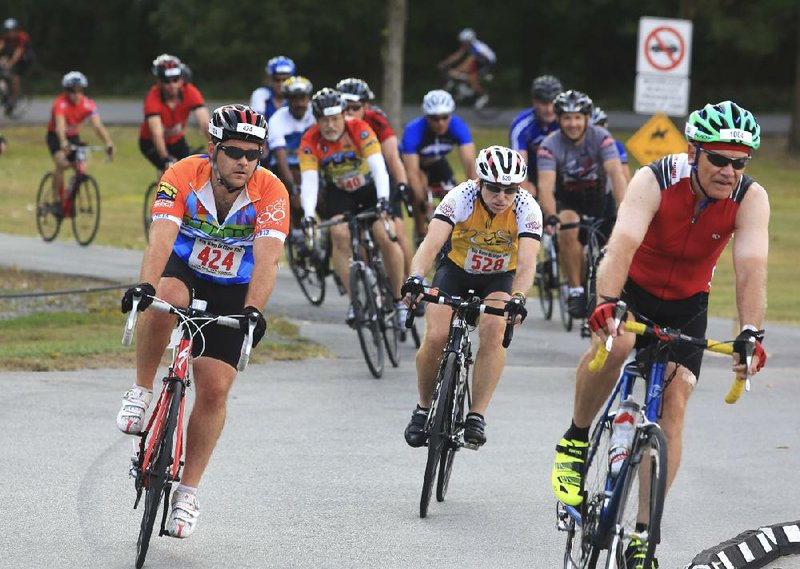Before 2,600 able bodies clamber onto bicycles and elbow their way into the thick of the Big Dam Bridge 100, Chainwheel and LeBorne Coaching want to teach at least some of them how to behave during Arkansas' largest group ride.
They're talking bike manners. Etiquette. Getting along with other cyclists in a group.
"All these group rides that are out there, they really don't have any riding and group etiquette," says Ernie Lechuga, owner of the cycling and triathlon training business LeBorne.
Sponsored training before bike tours tends to focus on preparing bodies to go a distance. But whether a cyclist signs up to pedal 100, 68, 50 or 13 miles Sept. 27 in the Big Dam Bridge Foundation's signature event, all the conditioning in the world will come to naught if failure to communicate causes a crash at the first bump in the road.
So this year's Big Dam Bridge training includes group etiquette classes. The hope is that "you teach two or three people, and then they pass that along and all of a sudden -- all of Little Rock" understands that, in a group, looking out for everybody else is how you look out for yourself.
People who have registered or plan to register for the Big Dam Bridge 100 are invited to take their bicycles (and helmets, gloves, water and so forth: arrive prepared to pedal) to any or all of three sessions:
• 8 a.m. Saturday: Burns
Park Soccer Complex in North Little Rock. Lechuga will offer tips on group manners, drafting and handling skills, and he'll field questions. He'll assign participants to work on a few skills, which everyone will practice in small groups on streets and paved paths within the soccer complex.
• 8 a.m. Sept. 13: Same place and same plan, "making sure that people did their homework."
• 8 a.m. Sept. 20: Two Rivers Park near the restrooms. This speed-based, 68-mile group ride is for people who plan to finish the BDB 100-miler in about five hours. Designed to teach pacing, it's not a "no-drop" outing, although a support car will follow the group. After a gradual warmup inside the park, the pack will head out Arkansas 300 and focus on averaging 19 to 21 mph.
The first two classes are open to everybody -- any skill level. Lechuga expects each session will last two to three hours.
NO GETTING AROUND IT
Whether participants plan to pedal with a team of pals or will line up as a stranger among strangers and suffer with anxiety until the pack spreads out, "there's always a bunch of riders either coming by you or you're going around riders. You're always around people," Lechuga says.
Fortunately, cycling manners aren't rocket science. "It's just like driving rules. You don't do certain things," he says. Participants at the etiquette classes will cover such basics, but he also hopes people will bring up confusing situations they've seen or that they worry about.
"I hope we get a few beginners or even the people that have come to my rides," he adds, "so they can ask the questions. 'What happens if somebody comes in and then they're stuck in the middle of the road?' 'What happens if I drop my chain?' -- whatever the question is -- and hopefully I'll have an answer for all those questions."
Riding behind a stranger can be stressful. You don't know him; what if you can't trust him?
"Exactly," Lechuga says. "So what you do is you kind of learn to watch for different things, like being aware of what's coming up in front of you. And if you're looking out for everybody, you're also looking out for yourself. If there's a pothole in front of you, and the person in front of you hasn't seen it because they're talking or distracted or focusing on whatever, then you can call it out from behind and it just puts everybody at alert.
"The way it works is the person in front has to take care of the people behind."
He adds, "So the person in front gets to point out if there's a stick or a rock, a pothole, a right turn coming up. Make that be a habit that they're pointing stuff out and yelling stuff out for the people behind. And that will keep everybody aware.
"Once they start doing that, giving them the confidence, then they'll start looking for things as opposed to just worrying about the person in front of them."
Knowledge brings confidence, and confidence creates safety. "Riding a bike's all about being confident, and if you're not confident then you're going to make a bunch of mistakes, whether you're by yourself or in a group," he says.
There's more information about the tour at thebigdambridge100.com. More information about training is available by calling (501) 224-7651.
ActiveStyle on 08/18/2014
